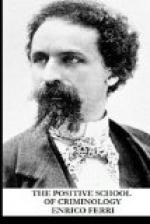This is the conception of our science, which thus succeeds in distinguishing traits of character even among the unlucky and forlorn people of the criminal world, while the classic school of criminology regards a criminal as a sort of abstract and normal man, with the exception of cases of minors, deaf mutes, inebriates, and maniacs.
In fact, the classic school of criminology regards all thieves as the thief, all murderers as the murderer, and the human shape disappears in the mind of the legislator, while it re-appears before the judge. Before the essayist and legislator, the criminal is a sort of moving dummy, on whose hack the judge may paste an article of the penal code. If you leave out of consideration the established cases of exceptional and rare human psychology mentioned in the penal code, all other cases serve the judge merely as an excuse to select from the criminal code the number of that article which will fit the criminal dummy, and if he should paste 404 instead of 407 on its back, the court of appeals would resist, any change of numbers. And if this dummy came to life and said: “The question of my number may be very important for you, but if you would study all the conditions that compelled me to take other people’s things, you would realize that this importance is very diagrammatic,” the judge would answer: “That’s all right for the justice of the future, but it isn’t now. You are number 404 of the criminal code, and after leaving this court room with this number pasted legally on your back, you will receive another number, for you will enter prison as number 404 and will exchange it for entry number 1525, or some other, because your personality as a man disappears entirely before the enactment of social justice!” And then it is pretended that this man, whose personality is thus absurdly ignored, should leave prison cured of all degeneration, and if he falls back into the path of thorns of his misery and commits another crime, the judge simply pastes another article over the other, by adding number 80 or 81, which refer to cases of relapse, to number 404!
In this way the classic school of criminology came to its unit of punishment, which it heralded as its great progress. In the Middle Ages, the diversity of punishment was greater. But in the 19th century the classic school of criminology combatted dishonoring punishment, corporeal punishment, confiscation, professional punishment, capital punishment, with its ideal of one sole penalty, the only panacea for crime and criminals, prison.
We have, indeed, prohibitory measures and fines even today. But in substance the whole punitive armory is reduced to imprisonment, since fines are likewise convertible into so many days or months of imprisonment. Solitary confinement is the ideal of the classic school of criminology. But experience proves that this penalty has as much effect on the disease of criminality, as the remedy of a physician would have, who would sit in the door of a hospital and tell every patient seeking relief: “Whatever may be your disease, I have only one medicine and that is a decoction of rhubarb. You have heart trouble? Well, then, the problem for me is simply—how big a dose of rhubarb decoction shall I give you?”




